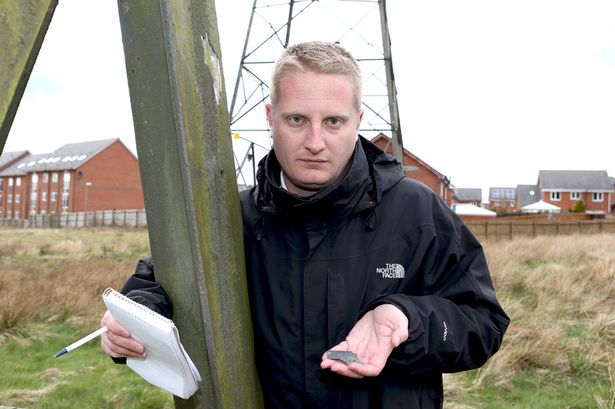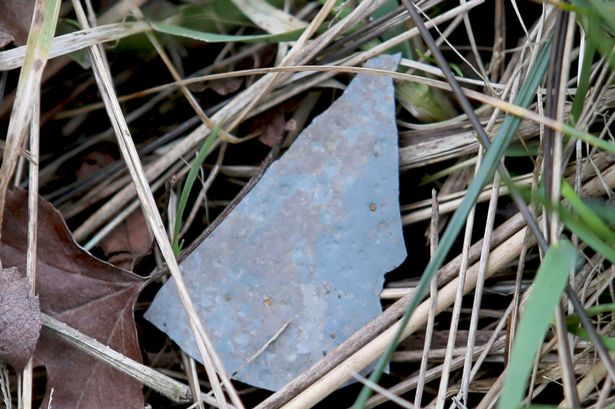SilverbladeTE
Senior Member
- Messages
- 3,043
- Location
- Somewhere near Glasgow, Scotland
http://www.mirror.co.uk/news/uk-news/poison-pylon-paint-fears-flakes-3300691
as usual, doing it on the cheap, and management poo-pooing any worries...makes ya sick, Standard Operating Procedure :/
as usual, doing it on the cheap, and management poo-pooing any worries...makes ya sick, Standard Operating Procedure :/
Poison pylon paint fears as flakes of toxic lead found near schools and farmland
Paint chippings from pylons contain enough toxins to cause possible fertility problems
Poisonous flakes of lead-filled paint litter the ground below an electricity pylon – just yards from a children’s swing and a primary school.
The chippings are packed with dangerously high levels of the metal and, after an investigation, our experts have found there is enough to cause serious damage, including possible fertility problems.
The threat was highlighted by a worried landowner whose property was littered with the flakes. There are around 88,000 pylons across the UK and he fears they could be a serious public health risk.
Yesterday the GMB union branded the situation “a disgrace” and praised the Sunday Mirror for bringing the issue to the attention of the public.
When the paint – often applied in the 1960s – begins to decay, maintenance workers are called to scrape off the dangerous old coating. Strict rules mean it should be disposed of in a safe and controlled manner.

The Sunday Mirror's Ben Glaze investigates paint that has been scrapped from Electricity Pylons in the area
But rather than using special wrapping – claimed to cost £28,000 per pylon – it is believed contractors in Lancashire have just scrubbed away previous coats with wire brushes and let debris float to the ground.
Experts say exposure to even low levels of lead can cause harm. It is known to be toxic to organs and tissue including the heart, bones, intestines, kidneys and reproductive and nerve systems.
It is particularly dangerous to children and can cause learning and behavioural disorders. Other symptoms when there
are high levels include abdominal pain, confusion, headaches, anaemia, irritability and, in the most severe cases, seizures, comas and even death.
We took two samples from an allotment, which has a swing in the middle and is near a school. Results revealed the flakes were “toxic for reproduction” and may cause “malformation”.
Before our probe, our source, who lives near Preston, Lancs, had already conducted four tests on scrapings below pylons near his home, and results came back showing all contained toxic levels.
He has been trying to get the issue tackled for three years but in January this year workmen began taking paint off a pylon on his land, too.
Worryingly, he witnessed geese and hens from the allotment pecking around by the scrapings, raising fears the animals had ingested chemicals and passed them into the food chain. “This stuff is toxic. On a windy day it goes everywhere. It could get into the food supply. Here on the allotments people are going to be cutting their veg and putting it into their cooking pots that night,” our whistleblower said.
“Similarly, if people eat eggs laid by these hens, how do they know what’s in them?
“And what about the little girl playing on the swing who picks up a piece of this paint and says, ‘What’s this, Daddy?’ before putting it near her mouth?”

When the old paint is removed it is left on the ground near schools and homes
Both Electricity North West, which is responsible for the pylon we tested, and the Government’s Environment Agency said they were investigating.
It is thought thousands of pylons across the UK could still have layers of old paint containing lead beneath more recent coats – meaning the rest of the nation could also be at risk. Our source said: “These things were put up all over the country and were painted with heavy lead paint because they couldn’t make other paint stick in the outside environment. Yes, they need to repaint these pylons to protect them for the future, but that doesn’t mean they can contaminate the land.”
Our tests in Lancashire revealed lead contents of 5.42 per cent and 3.23 per cent. The flakes were rated H10 and H14, meaning they were “ecotoxic” and “toxic for reproduction”.
Substances classified as H10 are those “which, if they are inhaled or ingested or if they penetrate the skin, may induce non-hereditary congenital malformations or increase their incidence”.
Ecotoxic waste “presents or may present immediate or delayed risks for one or more sectors of the environment”.
Wyndham Johnston, of LPD Lab Services, which conducted the tests, said: “Your two samples have a significant amount of lead. Five per cent of that paint flake by weight is lead, which is a lot. Ecotoxic is toxic in the environment and toxic for reproduction means you can have issues with any reproducing – animals and humans – if you’re having a baby.”
He warned that animals chewing on paint flakes would be consuming lead, adding: “The worst thing is if you ingest it – eating it or breathing it in.”

Imposing: The pylons
Mr Johnston said the flakes should only be removed by “a proper hazardous waste contractor”.
Our team was also taken to a nearby site next to a modern housing estate and discovered paint littering long grass below two pylons.
Our whistleblower first sent samples to be examined in May 2011 and was horrified when the results confirmed his worst fears. A report said: “All the submitted samples tested are considered to be hazardous in nature and will therefore require specialist disposal.”
As well as lead, they also contained chemicals, cadmium and chromium, in “trace quantities”.
A second test also came back positive and a report warned: “The lead values are high and represent considerable toxic potential. Advice should be sought from an Environmental Health Specialist.”
A separate analysis for Electricity North West in September 2011 concluded: “All the samples contain lead associated with the oldest paint layers.” It added: “It is recommended Electricity North West seek advice from a specialist consultant with regard to the toxicity and potential risk to cattle.” The landowner raised concerns with Electricity North West and the Environment Agency over what officials were doing to warn the school and allotment owners about the potential danger.
A letter last year from Agency chairman Lord Chris Smith said: “We requested that the Energy Networks Association’s membership develop a methodology to include the collection and disposal of waste as a best practice approach.
“We requested this was adopted throughout the sector. I am satisfied this is the most responsible way to secure an environmentally sound approach.”
But the landowner accused the Agency of being “unbelievably blasé”.
The GMB spokesman called on the Health and Safety Executive to begin immediate discussions with power companies to put in place a national programme to protect people. A spokesman added: “It’s a disgrace that our national infrastructure in private hands is deteriorating in this way.”
Local Labour MP Graham Jones said Electricity North West had vowed to ensure no more paint was removed until the issue was explored.
He added: “There is a probability it is private contractors. Clearly there needs to be a risk assessment. The public quite naturally will be concerned and it is important ENW not only act but keep people informed.”
Electricity North West said: “We are working with the Environment Agency following a specific complaint.”
